Overview
This article delves into the best practices for integrating software applications, underscoring the critical role of strategic approaches in enhancing operational efficiency and business performance. Why is effective integration essential? It is not merely a technical necessity; it is a strategic imperative that organizations must embrace to stay competitive in an ever-evolving landscape.
We will explore various integration methods, their benefits, and the challenges that come with them. Furthermore, we will examine future trends that highlight the growing importance of integration in business strategy. As a result, organizations that prioritize effective integration will position themselves advantageously in the marketplace.
Consider the implications: without a robust integration strategy, how can businesses adapt and thrive? This overview serves as a compelling call to action for organizations to rethink their integration strategies and invest in solutions that drive success. The effective integration of software applications is not just beneficial; it is essential for navigating the complexities of today’s business environment.
Introduction
In the rapidly evolving digital landscape, the integration of software applications stands as a crucial driver of operational efficiency and strategic advantage for organizations. As businesses increasingly depend on a myriad of software solutions, the ability to connect disparate systems seamlessly transcends mere technical necessity; it becomes a strategic imperative.
This article delves into the multifaceted world of software application integration, exploring its benefits, challenges, and best practices.
- How can organizations enhance data accuracy and streamline processes while overcoming common hurdles like data compatibility and security concerns?
- Understanding the nuances of integration empowers organizations to thrive in a competitive environment.
- Furthermore, as the integration landscape continues to evolve, staying abreast of emerging trends and leveraging innovative technologies will be essential for businesses aiming to maintain agility and drive growth.
Understanding Software Application Integration
The integration of software applications is essential for linking diverse software systems, facilitating smooth collaboration and data exchange. This combination is crucial for businesses aiming to streamline operations and enhance efficiency. In an era where organizations increasingly depend on various software tools, effective integration is vital for these systems to communicate efficiently. This communication is essential for achieving operational excellence and improving customer experiences.
The benefits of unifying software systems are extensive. By enabling the flow of information between systems, businesses can reduce redundancy, minimize errors, and accelerate decision-making processes. Recent trends indicate that over 50% of developers prioritize encryption in their applications, underscoring the growing emphasis on secure data management in collaborative efforts.
Furthermore, the hybrid connectivity platform addresses security concerns, ensuring that sensitive data remains safeguarded throughout the connectivity process while maximizing and extending the value of legacy systems.
Real-world examples highlight the transformative impact of connectivity on operational efficiency. For instance, the hybrid unification platform has been instrumental in helping organizations in regulated sectors, such as banking and healthcare, overcome the challenges posed by disconnected legacy systems. Clients like Gustavo Estrada, Acting Provincial Director of Performance & Transformation at BC Provincial Health Services Authority, have praised the company for its ability to streamline complex projects and deliver results within specified timelines and budget constraints.
This capability not only enhances operational functions but also empowers companies to respond swiftly to changing market demands, ensuring round-the-clock availability and reliability.
As we approach 2025, the importance of software application unification continues to grow. Statistics reveal that 40% of large companies utilize Java for managing complex systems, emphasizing the need for robust unification strategies that the company supports. With backing for 12 levels of interface maturity, Avato enables businesses to balance rapid implementation with the sophistication required to future-proof their technology stack.
Achieving effective integration of software applications not only drives efficiency but also ensures that businesses remain competitive in an ever-evolving landscape. In summary, the integration of software applications transcends mere technical necessity; it represents a strategic imperative that can significantly enhance business performance and customer satisfaction.
Exploring Different Types of Application Integration Methods
The integration of software applications can be achieved through various effective methods, each designed to address specific business requirements and complexities. Here’s a closer look at the most prominent techniques:
- Point-to-Point Integration: This method creates direct links between two systems. Although it is appropriate for simple connections, it can swiftly turn unwieldy as the quantity of systems grows, resulting in a complicated network of links that are hard to oversee.
- Middleware Integration: By utilizing a middleware layer, this method enables communication between various systems, providing a more scalable and manageable solution. Middleware acts as a bridge, allowing disparate systems to work together seamlessly, which is particularly beneficial in complex IT environments where various legacy systems must be integrated. Experts frequently emphasize the benefits of middleware in managing complex connections compared to point-to-point approaches.
- API-Based Integration: This method leverages Application Programming Interfaces (APIs) to enable applications to communicate and share data. API-based connectivity promotes flexibility and modularity, allowing businesses to adapt quickly to changing demands. Current trends show a notable increase in API adoption, with organizations increasingly acknowledging the importance of APIs in improving connectivity capabilities. The hybrid integration platform exemplifies this trend by providing a robust framework that accelerates secure system integration, particularly for sectors like banking, healthcare, and government.
- Event-Driven Integration: In this approach, applications respond to specific events or changes in data, facilitating real-time updates and interactions. This method is especially beneficial in settings where prompt data processing is essential, such as in banking and healthcare fields, where the platform guarantees dependable performance and security.
- Data Integration: This technique focuses on consolidating data from various sources into a unified view, which is essential for analytics and reporting. By integrating data effectively, entities can gain deeper insights and make informed decisions based on comprehensive information. Avato’s platform improves operational transparency and problem-solving, enabling companies to access isolated resources and generate substantial business value.
The selection of connection method for the integration of software applications depends on various factors, including the complexity of the connection, the number of systems involved, and the particular business needs. For example, entities employing numerous SaaS applications are expected to consolidate management by 2026, highlighting the increasing significance of the integration of software applications for efficient unification approaches. A prominent case study showcasing the effectiveness of unification techniques is Slack, which features over 2,400 SaaS connections. This extensive capability has not only enhanced user experience but also contributed to Slack’s growth, with 10 million daily users and widespread adoption among Fortune 100 companies. Such examples demonstrate the tangible advantages of strong unification strategies in driving business success, particularly through API-based and middleware connection methods.
As the landscape of software unification continues to evolve, understanding the nuances of each method will empower organizations to make informed decisions that align with their operational goals. The focus on delivering a dependable, future-ready technology stack, as shown by the commitment to designing technology foundations, is essential for companies to adjust to evolving demands and sustain a competitive advantage. Avato’s dedication to safe transactions and round-the-clock availability further strengthens its role as a reliable ally in the connectivity landscape.
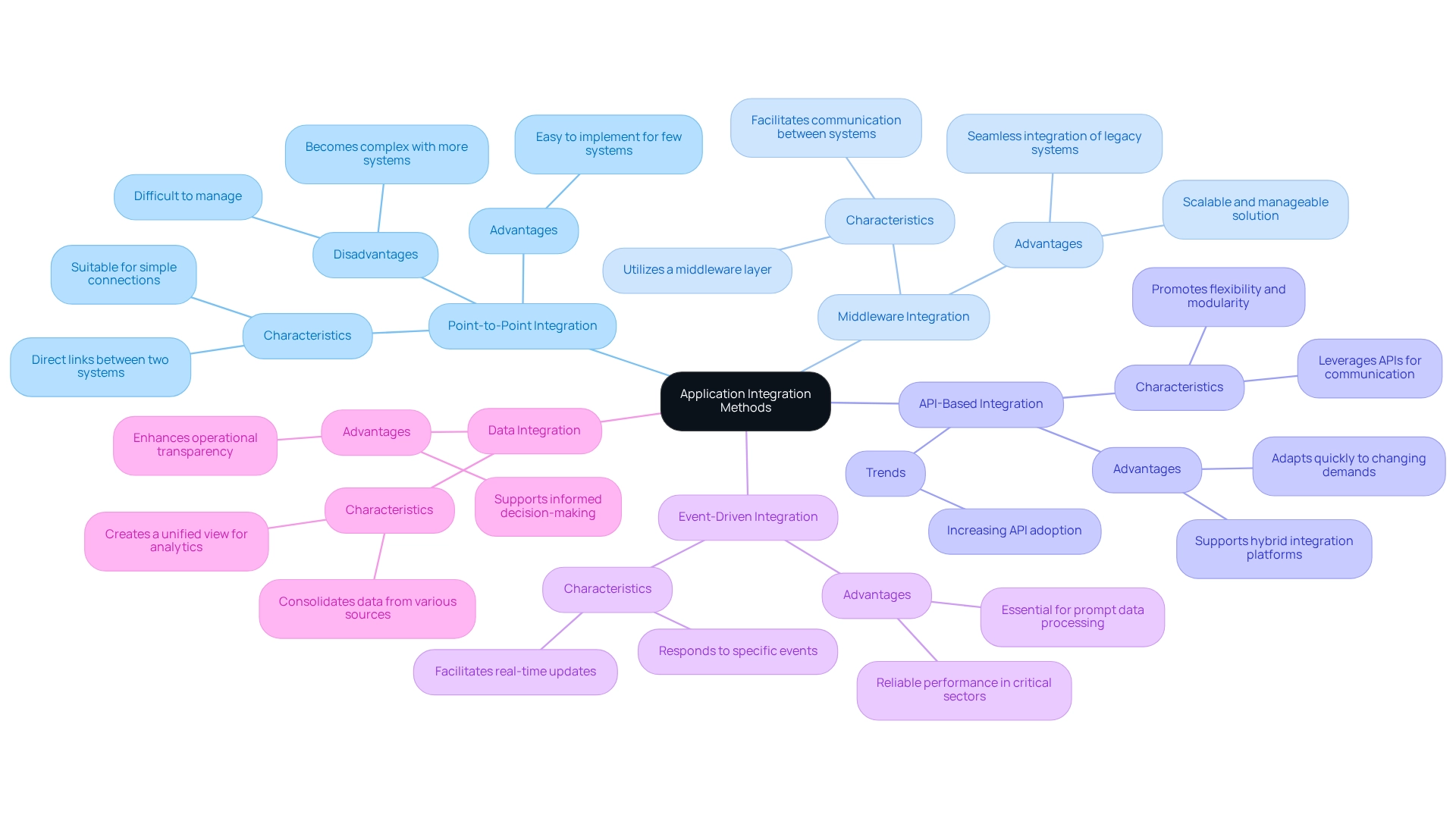
Benefits of Integrating Software Applications
Integrating software applications presents a multitude of advantages that can significantly enhance organizational performance.
- Increased Efficiency: By automating processes, the system reduces the need for manual intervention, enabling employees to focus on higher-value tasks. This shift not only boosts productivity but also allows for a more strategic allocation of resources. Recent statistics show that organizations utilizing software system unification can attain efficiency improvements of up to 30% in their operations. This is particularly relevant as one-third of CIOs struggle with hiring or upskilling employees to meet the growing demand for data science and cybersecurity roles. Moreover, the transformative impact of AI in financial services, as highlighted in NVIDIA’s 2025 survey, shows that nearly 70% of firms reported at least a 5% revenue increase attributable to AI implementations, underscoring the potential of integrated systems to drive efficiency and revenue.
- Improved Data Accuracy: Integration effectively reduces data silos and inconsistencies, ensuring that all systems operate with the same accurate information. This uniformity is crucial for making informed decisions and maintaining operational integrity, especially in a landscape where AI tools are increasingly used for data processing and report generation.
- Enhanced Collaboration: When applications share data and functionality, teams can collaborate more effectively. This interconnectedness fosters better decision-making and accelerates project timelines, as stakeholders have access to real-time information. The incorporation of AI-driven tools can further improve customer engagement and support, transforming how teams interact with clients.
- Cost Reduction: Streamlined operations and the elimination of redundant processes can lead to substantial cost savings over time. Organizations that adopt a cohesive approach often discover that they can function more efficiently, lowering overhead and enhancing their profit. Case studies reveal that companies that have integrated their systems report a 25% reduction in operational costs, underscoring the tangible benefits of this approach. Additionally, the survey indicates that over 60% of firms noted cost reductions of 5% or more due to AI implementations, highlighting the dual benefits of integration and AI.
- Faster Time to Market: Integrated systems enable businesses to respond swiftly to market changes and customer demands. This agility is essential in today’s fast-paced business environment, where the ability to adapt can be a significant competitive advantage. The rapid adoption of generative AI tools, as reported in the survey, illustrates the need for financial institutions to integrate these technologies into their operations to stay ahead.
Additionally, more than 50% of developers utilize encryption in their software, highlighting secure data management as a development priority. This emphasizes the significance of secure methods in software system unification, ensuring that entities can safeguard their data while enjoying the advantages of unification.
Expert insights from Kashyap Pujara, an experienced project manager and IT expert, reinforce that the integration of software applications not only enhances operational efficiency but also improves data accuracy, which is vital for strategic decision-making. Business leaders consistently highlight that the efficiency improvements from unification are transformative, allowing entities to flourish in a progressively intricate environment. As the enterprise software market is anticipated to attain $401.60 billion by 2029, the significance of efficient unification strategies will only continue to increase, establishing it as a vital focus for contemporary businesses.
Moreover, the difficulties highlighted in the case study ‘Barriers to Digital Transformation Progress’ demonstrate how unification can assist entities in overcoming hurdles like cyber threats and skills shortages, further underscoring its importance in today’s digital environment.
To effectively mobilize stakeholders and ensure successful incorporation, organizations should engage in thorough process modeling and future-proofing strategies. Avato provides customized solutions to help banking IT managers tackle these challenges, ensuring that collaborative efforts align with organizational objectives and promote sustainable growth.
Common Challenges in Software Application Integration
Organizations frequently encounter a myriad of challenges during the integration process, significantly impacting their operational efficiency and effectiveness. Among these, data compatibility issues stand out. The diversity of data formats across different systems complicates seamless information sharing. As entities work to combine legacy systems with contemporary software, ensuring compatibility becomes crucial. Leveraging XSLT can greatly enhance this process, as it is a highly-tuned declarative programming language that simplifies the transformation of XML data structures. By utilizing XSLT, organizations can eliminate substantial labor associated with data manipulation tasks, while schemas help catch programming errors early, resulting in significant cost savings.
Moreover, in 2025, over 50% of developers are anticipated to employ encryption in their software, underscoring the essential requirement for secure data management amidst these compatibility challenges. The situation of Merge illustrates how a unified API can simplify connection processes, enabling businesses to streamline their efforts and respond effectively to customer connection requests. Security concerns also arise as the combination of multiple applications can heighten the risk of exposing sensitive data. To mitigate these risks in cloud-native environments, security-first development practices, such as DevSecOps, are increasingly becoming standard. Organizations must prioritize robust security measures to protect against potential breaches during the unification process. As Gustavo Estrada noted, the company simplifies complex projects and delivers results within desired time frames and budget constraints, emphasizing the significance of effective solutions in addressing security concerns. Avato’s architecture for secure transactions further enhances its reliability in sensitive environments.
The lack of standardization presents another challenge. The absence of standardized processes and protocols can lead to chaotic unification efforts. Without a cohesive strategy, organizations may struggle to handle connections efficiently, resulting in heightened complexity and possible failures. Additionally, resource constraints can significantly impede the merging process. Organizations frequently encounter delays and higher expenses when they lack the essential skills or staff to carry out projects effectively. Notably, automation in DevOps is projected to reduce manual workloads by 45% by 2025, offering a potential solution to alleviate some of these resource constraints.
Change management is yet another critical factor. Resistance to change from employees can pose a significant barrier to the successful adoption of new integrated systems. Effective change management strategies are essential to facilitate a smooth transition and ensure that staff are on board with new processes and technologies. Avato’s hybrid connection platform, which supports 12 levels of interface maturity, is designed to aid entities in navigating these changes, ensuring that personnel are equipped with the necessary training and resources to adapt to new systems.
Addressing these challenges requires a strategic approach, leveraging insights from industry experts and successful case studies. By comprehending and actively addressing these challenges, entities can improve their coordination efforts and reach their digital transformation objectives. Ongoing observation and analysis are vital in enhancing performance, enabling entities to detect and address problems swiftly.
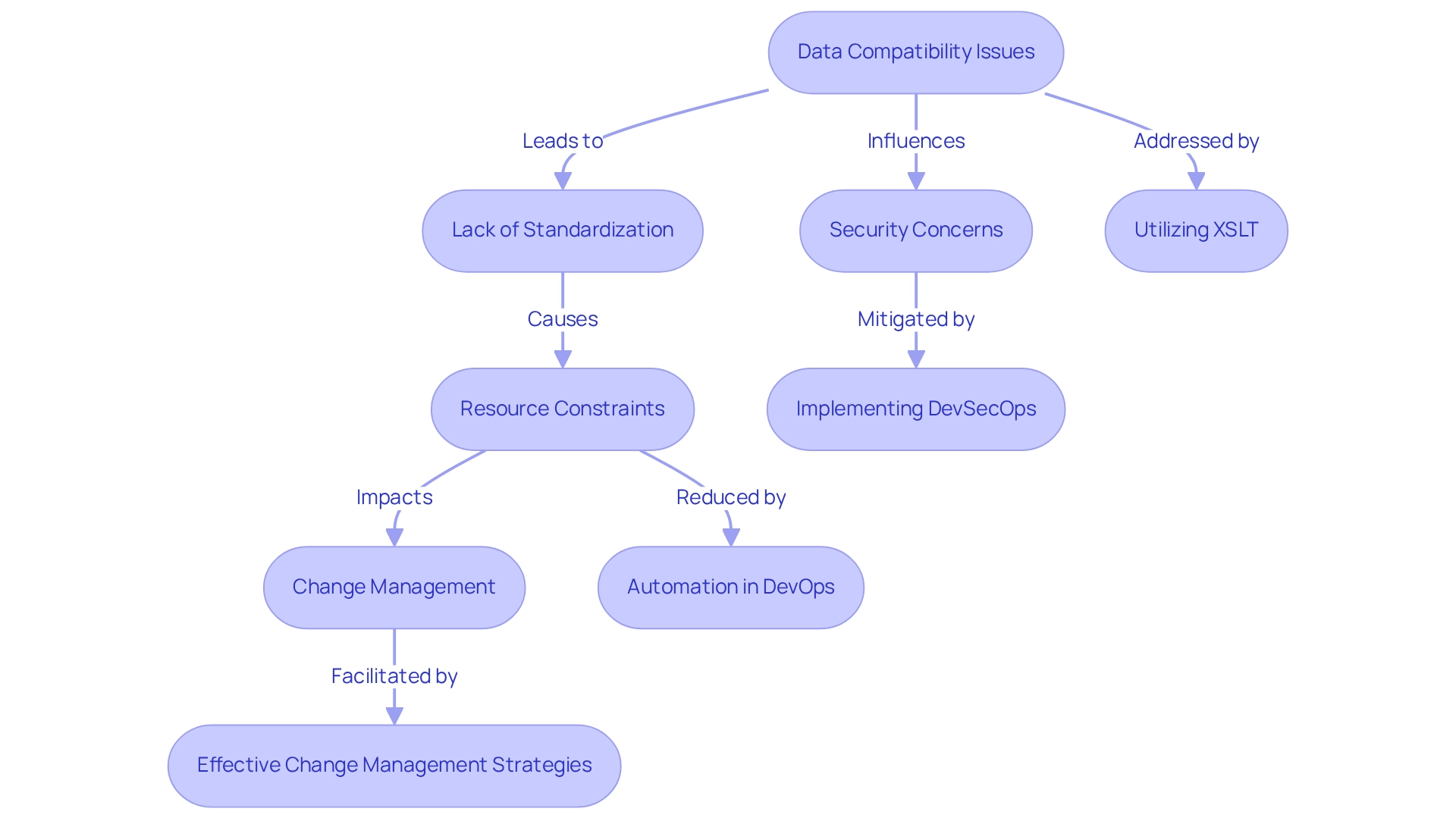
Best Practices for Successful Software Integration
To achieve successful software integration, organizations should consider the following best practices:
-
Define Clear Objectives: Establishing specific goals for the unification project is crucial. Clear objectives guide decision-making and provide measurable benchmarks for success, ensuring that all team members are aligned with the project’s vision.
-
Involve Stakeholders Early: Engaging relevant stakeholders from the outset is essential for fostering alignment and securing support throughout the merging process. Studies show that entities with robust stakeholder engagement achieve a 30% greater success rate in their unification efforts. This engagement not only enhances collaboration but also helps in identifying potential challenges early on. As Gustavo Estrada observed, “The company has the ability to simplify complex projects and deliver results within desired time frames and budget constraints,” highlighting the importance of stakeholder engagement in achieving project success.
-
Choose the Right Tools: Selecting connection tools and platforms that align with your organization’s specific needs and capabilities is vital. Avato’s hybrid unification platform is designed to streamline digital transformation by managing structured requirements effectively, particularly for legacy systems in regulated industries. The appropriate technology can enhance efficiency and result in a more successful incorporation outcome. With the anticipated expansion of low-code and no-code platforms hitting $65 billion by 2027, organizations should evaluate these technologies to improve their collaboration efforts.
-
Document Everything: Keeping detailed records of merging processes, configurations, and changes is essential. This practice facilitates troubleshooting and future updates, ensuring that teams can quickly address issues as they arise and adapt to evolving requirements. Avato highlights the significance of organized documentation to facilitate smooth connection among varied systems.
-
Test Rigorously: Conducting extensive testing of integrations before deployment is a best practice that cannot be overlooked. Rigorous testing helps identify and resolve issues proactively, reducing the risk of disruptions post-launch. Organizations that prioritize testing report a 40% decrease in integration-related failures.
Furthermore, numerous entities face typical challenges during digital transformation, such as conflicting priorities and reluctance to change. By adhering to these best practices, organizations can navigate these complexities more effectively, ultimately leading to enhanced operational capabilities and a stronger competitive position in their respective industries. Significantly, 60% of outsourcing services worldwide are associated with software development, underscoring the importance of the integration of software applications in today’s market environment.
Obtain your copy now to discover how Avato can assist you in simplifying complex projects and increasing your business value through organized requirements management.
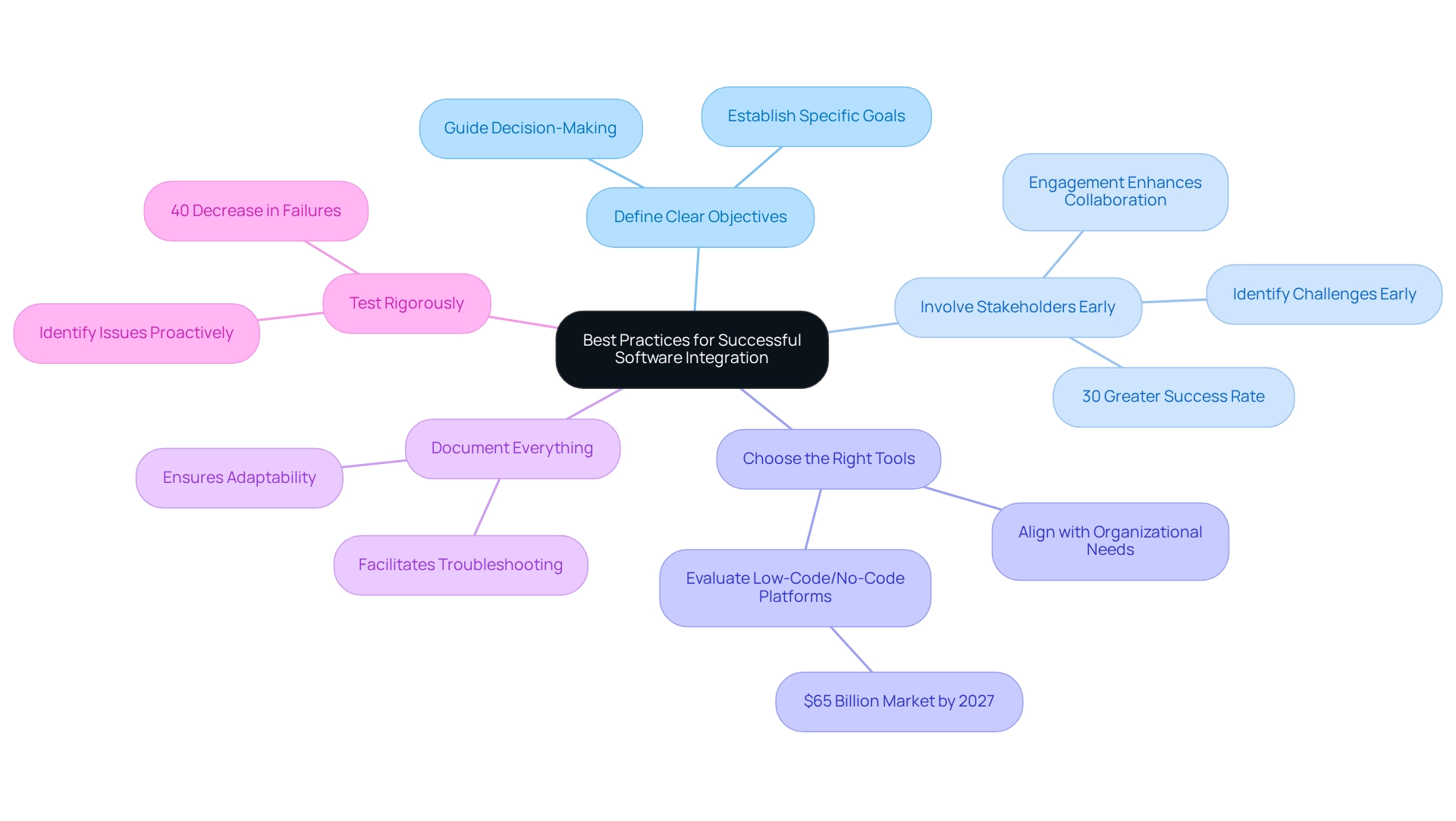
Leveraging Technology for Effective Application Integration
Technology is pivotal in enabling effective application integration, with several key considerations shaping the landscape in 2025. Integration Platforms as a Service (iPaaS) are becoming increasingly vital, offering pre-built connectors and tools that enhance the integration of software applications and enable smooth connectivity across various systems. As organizations adopt cloud-first strategies, the demand for iPaaS is projected to surge, with analysts estimating that over 85% of enterprises will prioritize cloud solutions by the end of the year. This trend highlights the crucial role of software application integration, including Avato’s hybrid unification platform, in enabling digital transformation and increasing business value.
Furthermore, robust API management tools are critical for ensuring secure and efficient communication between applications. Efficient administration of APIs not only improves security but also simplifies the integration of software applications, enabling businesses to utilize their current systems more effectively.
Middleware serves as a vital bridge between disparate systems, simplifying the integration of software applications and enabling smoother data flow. This technology is particularly beneficial in environments where the integration of software applications, including legacy systems and modern applications, ensures continuity and operational efficiency. Avato excels in this area, assisting entities in bridging the gap between legacy systems and modern expectations.
In addition, precise data transformation and transfer are essential for preserving data integrity during consolidation. Data mapping tools assist entities in ensuring that information is accurately aligned between systems, thereby minimizing errors and improving the reliability of software application integration.
Moreover, implementing comprehensive monitoring and analytics tools allows organizations to track performance and identify issues in real-time. This proactive strategy not only reduces downtime but also encourages ongoing enhancement in connection processes.
As the landscape of unification evolves, the integration of software applications, along with the adoption of AI and machine learning technologies, is transforming the iPaaS market and further enhancing the capabilities of connectivity solutions. By leveraging these advanced technologies, organizations can optimize their software application integration strategies, ensuring they remain agile and competitive in a rapidly changing environment. Gustavo Estrada, a client, emphasizes the effectiveness of the company, stating, “The platform simplifies complex projects and delivers results within desired time frames and budget constraints.”
This underscores the importance of a reliable technology stack, like that provided by Avato, which is crucial for businesses to adapt to changing demands. With 25,000 entities expanding using the sync apps connection platform, the efficiency of connection solutions is clear.
Monitoring and Maintaining Integrated Applications
To ensure the longevity and effectiveness of integrated applications, entities should adopt the following best practices:
- Implement Continuous Monitoring: Leverage advanced monitoring tools to track the performance and health of integrated systems. This proactive approach enables swift identification of issues, allowing teams to respond effectively before minor problems escalate into significant disruptions. Continuous monitoring is a game-changer for IT consulting services, facilitating proactive management and minimizing downtime. In 2025, entities employing Avato’s hybrid connection platform can gain from strong analytics features that offer insights to enhance operations, elevate customer experiences, and discover new avenues for innovation. For instance, website performance management increasingly depends on observability strategies that monitor third-party scripts, addressing intertwined challenges of performance and security. Teams are expected to deploy proxy environments to pre-screen third-party scripts, enhancing website safety and performance by blocking dangerous scripts and optimizing those with performance issues.
- Regularly Update Connections: Keeping connections current with the latest software versions and security patches is crucial for mitigating risks. In 2025, entities are expected to prioritize frequent updates, as obsolete connections can expose systems to vulnerabilities and performance problems. Statistics from the UserEvidence survey indicate that 67% of organizations report updating their systems at least quarterly to maintain security and functionality, underscoring the importance of frequent updates. This practice is essential not only for performance but also for ensuring compliance with evolving regulatory standards.
- Conduct Periodic Reviews: Regular evaluations of performance against established KPIs are vital for identifying areas for improvement. These evaluations should concentrate on metrics like response times, error rates, and user satisfaction, ensuring that connections continue to fulfill organizational requirements efficiently. Avato’s dedication to delivering results through its hybrid unification platform supports these assessments by unlocking isolated assets and enabling business value creation.
- Establish a Support Framework: Creating a dedicated support team to address integration-related issues is essential. This team should be prepared to offer prompt support to users and address any issues that emerge, ensuring that interconnected systems operate seamlessly and effectively.
- Document Changes and Updates: Keeping detailed records of any modifications made to connections is essential for enabling troubleshooting and future improvements. Documentation should include details about updates, performance metrics, and any issues encountered, providing a valuable resource for ongoing management and optimization. This practice not only assists in operational integrity but also bolsters compliance initiatives, particularly as 67% of global leaders perceive ESG regulation as overly complex.
By adopting these best practices, organizations can enhance the performance and security of their integrated systems through the integration of software applications, ensuring they remain resilient and efficient in a continually changing technological environment. Avato’s commitment to designing technological foundations enables companies to safeguard their operations for the future through smooth data and system unification.
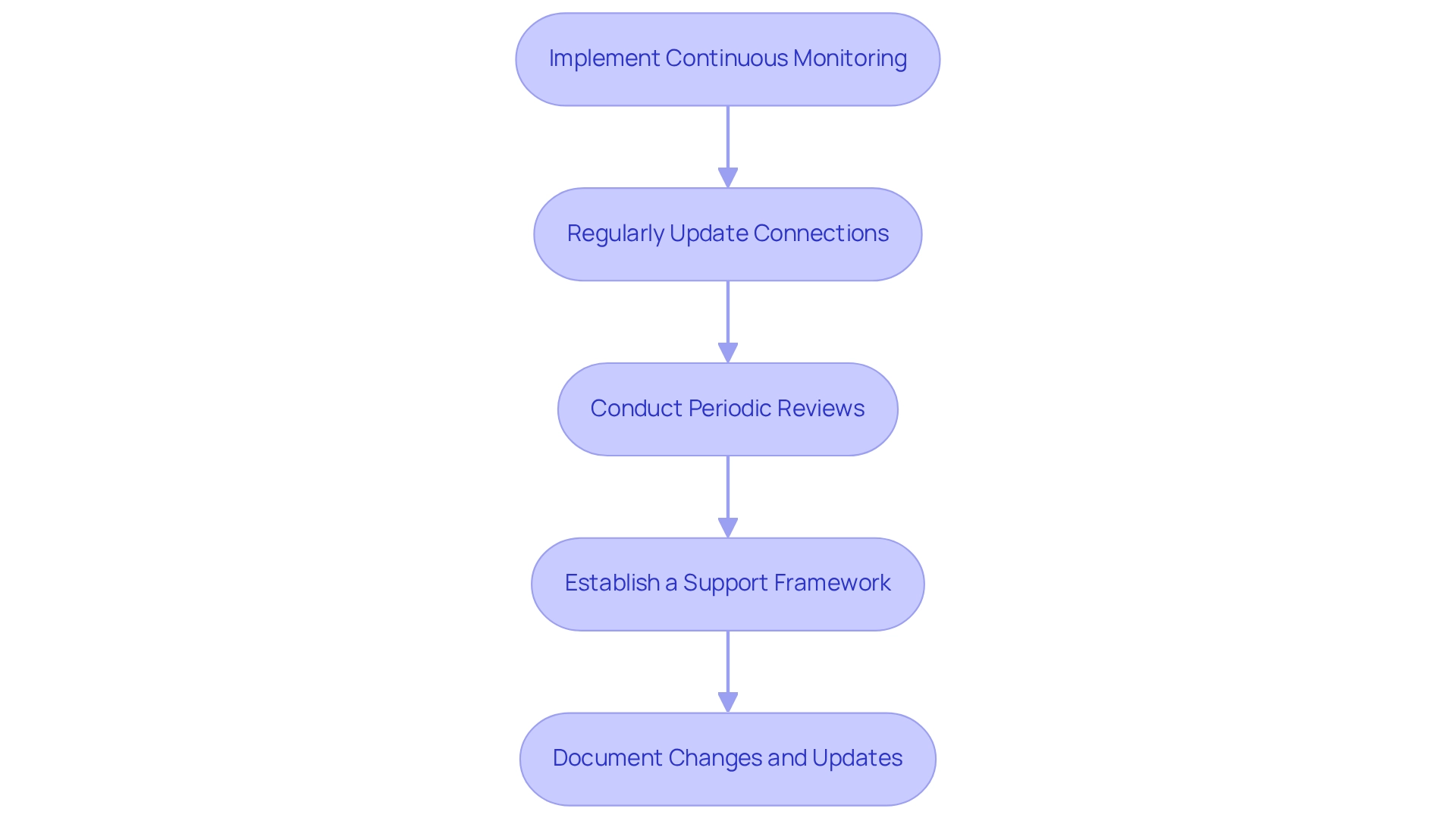
Future Trends in Software Application Integration
As technology continues to evolve, several key trends are shaping the future of software application integration:
- Increased Adoption of AI and Machine Learning: The incorporation landscape is witnessing a significant shift as organizations leverage AI and machine learning to automate processes and enhance data analysis. This trend is underscored by the fact that a majority of respondents report cost reductions across various business functions due to the effective use of generative AI. In financial services, generative AI has seen a 60% increase in use for customer experience, particularly in developing sophisticated chatbots and virtual assistants. Furthermore, 59% of machine learning professionals mention Amazon Web Services as their most utilized cloud platform, suggesting a strong dependence on cloud solutions for AI implementation.
- Rise of Low-Code/No-Code Platforms: The emergence of low-code and no-code platforms is democratizing access to connectivity tools, enabling non-technical users to create and manage connections. This change is especially significant as 42% of participants are employed by entities with over $500 million in yearly revenues, emphasizing the magnitude of organizations embracing these platforms to simplify their connection processes.
- Focus on Real-Time Data Integration: Organizations are prioritizing real-time data sharing to improve decision-making and responsiveness. This trend is critical as businesses seek to enhance operational efficiency and customer engagement, with 21% of companies already implementing AI-powered chatbots to personalize customer journeys. Avato’s hybrid unification platform plays a crucial role in this transformation, simplifying complex connections and delivering cost-effective solutions that enhance customer service and engagement through real-time data unification.
- Greater Emphasis on Security: As unification becomes more complex, ensuring data security and compliance is paramount. Organizations are becoming more conscious of the risks linked to data breaches and are investing in strong security measures to safeguard sensitive information during merging processes. Arvato is relied upon by financial institutions, healthcare, and government sectors for its secure transaction framework, guaranteeing that connection projects maintain 24/7 uptime with no allowance for defects or outages.
- Expansion of Hybrid Connection Solutions: Businesses are adopting hybrid connection approaches that combine on-premises and cloud-based solutions. This strategy maximizes flexibility and scalability, allowing organizations to adapt to changing demands while maintaining a competitive edge. Significantly, 63% of leading companies are boosting their investment in cloud technology to enhance the utilization of generative AI, indicating a wider trend towards hybrid solutions in unification. The platform is designed for collaboration projects where speed and reliability are crucial, supporting 12 levels of interface maturity to ensure technology stacks are future-ready.
These trends suggest a dynamic change in the collaboration landscape, propelled by technological innovations and the necessity for entities to stay adaptable and secure in an increasingly complex environment. The hybrid integration platform is ideally situated to support these trends, offering essential tools and capabilities for the integration of software applications to assist organizations in navigating the changing landscape effectively. As Tony Leblanc from the Provincial Health Services Authority noted, “Good team. Good people to work with. Extremely professional. Extremely knowledgeable,” highlighting Avato’s commitment to excellence in integration solutions.
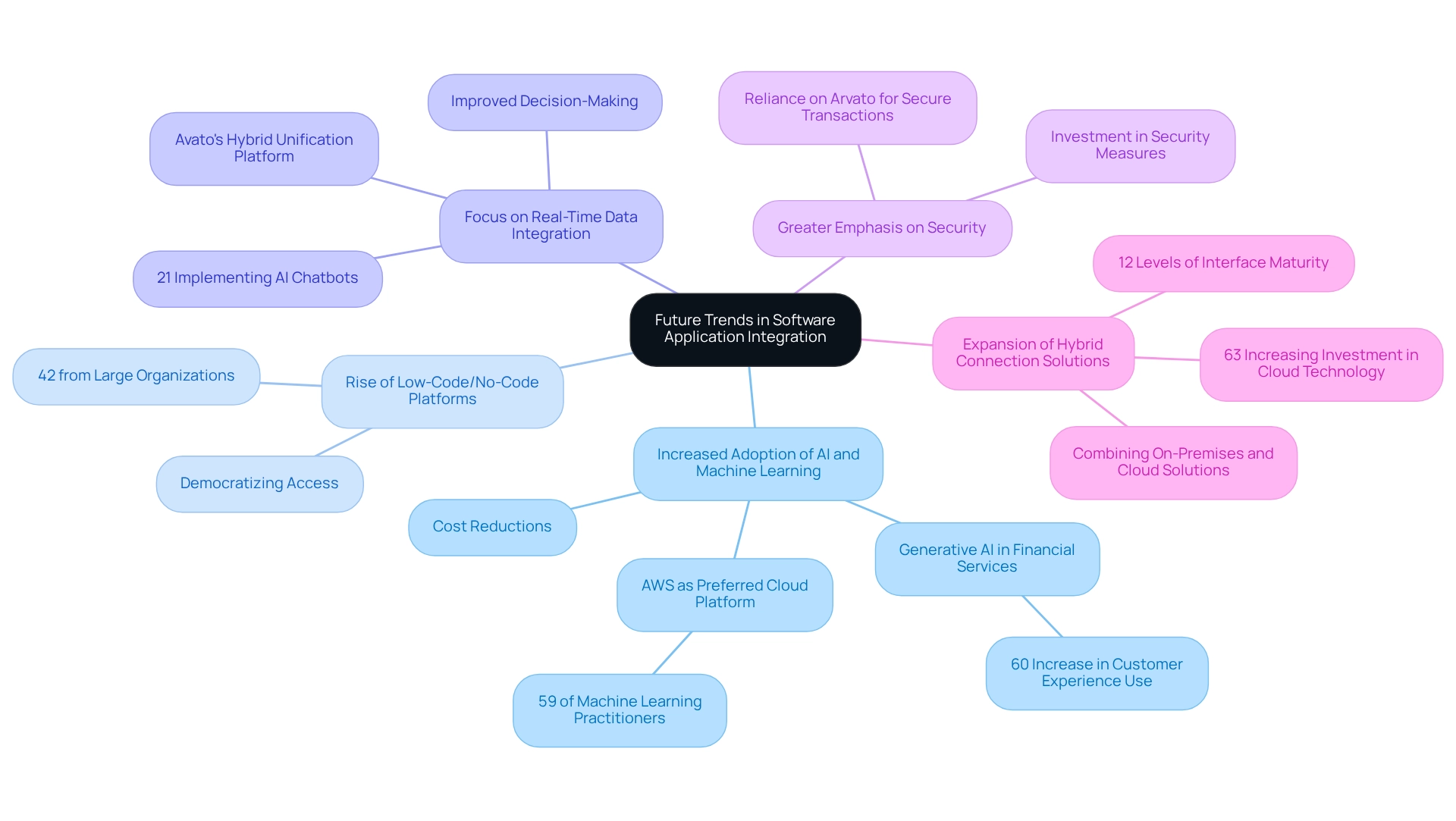
Conclusion
The integration of software applications transcends mere technical requirements; it stands as a strategic necessity capable of driving substantial improvements in efficiency, data accuracy, and overall business performance. By uniting disparate systems, organizations can streamline operations, minimize errors, and bolster collaboration, ultimately positioning themselves for success in a competitive landscape.
However, the pathway to successful integration is fraught with challenges. Issues such as data compatibility, security concerns, and resource constraints can impede progress. Organizations must adopt best practices, engage stakeholders, and select the appropriate tools to navigate these obstacles effectively. Continuous monitoring and regular updates are imperative for maintaining the integrity and performance of integrated systems.
Looking ahead, emerging trends—such as the increased adoption of AI, the rise of low-code/no-code platforms, and a focus on real-time data integration—will significantly influence the future of application integration. Businesses that prioritize these developments will be better equipped to adapt to changing market demands and sustain a competitive edge.
In conclusion, embracing software application integration is essential for modern organizations striving to enhance operational efficiency and customer satisfaction. By leveraging innovative technologies and adhering to best practices, businesses can unlock the full potential of their integrated systems, driving growth and resilience in an ever-evolving digital landscape.

